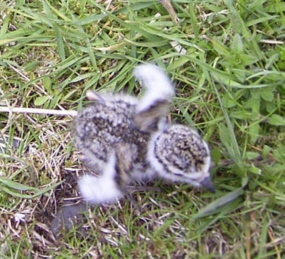- Charadrius hiaticula
Identification
A small plover, 17-19.5 cm body length, with a distinctive bold black and white pattern on the head, short orange bill with black tip and orange legs. The grey-brown upperparts blend well with a variety of shingle and sand colours, so that a sitting bird is often unnoticed.
In winter, the legs usually becomes a little duller, the bill becomes mostly or all black, and the black in head and neck markings becomes browner and less distinct.
Immatures are similar but with many feathers having white edgings giving a scaly impression.
Similar species
Semipalmated Plover is closest, Little Ringed Plover the more common similar species in Europe
Distribution

Mainly Old World, marginal in North America: breeding from northeast Canada and Greenland to Europe (mostly northern half, including Britain) and northern Asia, wintering in southern Europe, Africa, and southern Asia. Vagrant to southern Canada, USA, and the Caribbean. Populations exhibit leapfrog migration, with the northernmost breeding birds (e.g. arctic Scandinavia) migrating the furthest south as far as South Africa, while birds breeding at the southern edge of the breeding range (e.g. Britain) only migrate short distances if at all.
Taxonomy
Subspecies
There are two or three subspecies1
- C. h. hiaticula - Ireland, Britain, northern France east through southern Scandinavia to the Baltic States; winters northwestern Europe south to western Africa.
- C. h. tundrae - arctic Scandinavia and Russia; winters Caspian Sea, southwest Asia to South Africa.
- C. h. psammodromus - north-eastern Canada, Greenland and Iceland; winters western to southern Africa. Included in C. h. hiaticula by some authorities.
Habitat

Mostly seen at the coast, but also found inland, wherever there is water with sandy or gravelly margins, e.g. gravel pits, reservoirs and in the tundra.
Behaviour
Ringed Plover can be almost impossible to see with the naked eye when on shingle beaches - one of its favourite habitats. Its movement, flight or plaintive call almost always reveal its presence, however.
Diet
The short bill is used to forage along the low water mark and amongst pebbles and drift seaweed. Sand hoppers and insects are favoured prey.
Breeding
The eggs are laid in a depression with no nest material at all, often just above the strandline, and may be inundated by exceptionally high tides. One parent sits on the nest while the other forages nearby. Disturbed birds will wait until they feel safe, then one will run up the shore to the nest.
Once hatched, the chicks are soon on the move, exploring their surroundings (see images of 2 ringed chicks). When danger threatens, a call from a parent causes them to freeze and sit tight until the parent calls the 'all clear'. Chicks are brooded beneath parents when conditions are cold or wet, but are left to find their own food. Like other wader chicks, their legs and feet appear oversized compared with the body and it takes several weeks before their proportions resemble those of the adult.
Adults will defend the young against predators 3-4 times their size, e.g. Herring Gulls; they will also perform a broken wing display to lead predators away from nests or chicks.
Vocalisation
Call: melodic too-li, coo-eep or queeo
<flashmp3>Charadrius hiaticula (song).mp3</flashmp3>
Listen in an external program
References
- Clements, JF. 2010. The Clements Checklist of Birds of the World. 6th ed., with updates to December 2010. Ithaca: Cornell Univ. Press. ISBN 978-0801445019. Spreadsheet available at http://www.birds.cornell.edu/clementschecklist/Clements%206.5.xls/view
- Collins Pocket Guide to British Birds 1966
- Collins Field Guide 5th Edition ISBN 0 00 219900 9
Recommended Citation
- BirdForum Opus contributors. (2024) Common Ringed Plover. In: BirdForum, the forum for wild birds and birding. Retrieved 26 April 2024 from https://www.birdforum.net/opus/Common_Ringed_Plover
External Links






